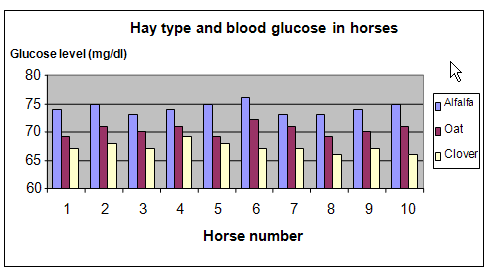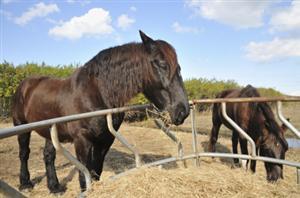| Complexity level: | 9 |
| Project cost ($): | 200 |
| Time required: | 1 day to prepare, 3 days for the science project experiment |
| Material availability: | The involvement of 10 healthy horses. A blood glucose meter, and participation of a horse handler. |
| Safety concerns: | Horses should be handled by qualified handlers at all times to avoid injury. |
Hypothesis
Alfalfa hay gives horses the most amount of energy. Our hypothesis is based on the popularity of alfalfa grass/hay as a form of feed.
Overview
Horses and hay
Horses are herbivores. They consume dry matter up to 2.5% of their body weight everyday. Most of the dry matter consumed by the horses consists of forage made into hay or hay cubes. A 450kg horse can consume up to 10kg of hay in a day!
Hay is a composition of various types of grasses and legumes. The contents of hay depend upon the plant composition at the fields where the hay was harvested. Other factors include the types of seeds used, germination rates, soil conditions and the age of the harvest.
Alfalfa hay is rated as being among the best hay to feed horses. Horses find this hay very palatable. It apparently contains about 20% more energy per unit weight compared to oat hay. However, this might cause overfeeding and make the horse overweight. Alfalfa hay is also rich in protein which is normally converted into energy compounds in the horses body.
Oat hay is also an excellent choice for feeding horses. It contains lower protein and marginal amounts of phosphorus, calcium and carotene. Another good choice is Clover hay. Oat and Clover hay are similar to Alfalfa hay and are normally mixed with grass hay before feeding.
Scientific Terms
Materials
The materials required for this science fair project:
- 10 horses
- 70kg of alfalfa hay
- 70kg of oat hay
- 70kg of clover hay
- 1 blood glucose tester
- 1 bottle alcohol
- 1 electric shaver
- 30 syringes
- A horse trainer
Procedure
1. For this science fair project, the independent variable is the type of hay used to feed the horses – alfalfa , oat and clover hay. The dependent variable is the glucose level in the blood of the horse after feeding. This is determined by using the blood glucose meter to test the glucose level in the horse’s blood. The constants (control variables) are the breed of the horse, the length of time between feeds and the time and method of taking blood samples as well as the amount of hay fed to the horses.
2. 10 horses are selected to participate in this science project experiment. The nature of the science project is explained to the horse owners and permission is obtained before proceeding. A horse handler’s participation will be required.
3. On the first day, each of the horses is fed with 7kg of alfalfa hay. One hour after the horses have finished consuming all of the hay, Blood samples are obtained from the horses with the syringe or other device that is provided with the blood glucose meter. The blood glucose meter is used to check the glucose level in the horse’s blood. All measurements are recorded in the table given below.
4. Procedure 3 is repeated on the second day using oat hay and on the third day using clover hay. The measurements are all recorded in the table given below.

Results
It was observed that the horses’ glucose levels were at their highest after feeding on alfalfa hay.
|
Hay type |
Glucose level in horse’s blood 1 hour after feeding on hay (mg/dl) |
|||||||||
|
1 |
2 |
3 |
4 |
5 |
6 |
7 |
8 |
9 |
10 |
|
|
Alfalfa hay |
74 |
75 |
73 |
74 |
75 |
76 |
73 |
73 |
74 |
75 |
|
Oat hay |
69 |
71 |
70 |
71 |
69 |
72 |
71 |
69 |
70 |
71 |
|
Clover hay |
67 |
68 |
67 |
69 |
68 |
67 |
67 |
66 |
67 |
66 |
The graph below represents the results of our science project experiment:

Conclusion
The hypothesis that Alfalfa hay gives horses the most amount of energy is proven to be true. Glucose is easily converted to energy in the horses’ bodies. Therefore, higher glucose levels means more energy is available to them.
Horses are herbivores and consume plants and legumes for food. Ideally, horses should be allowed to feed on pastures during the growing seasons. However, the need to house horses indoors and limited productive pastures necessitates the use of hay as the main source of food and nutrient for the horses.
Also consider
What would happen if this science project were to be repeated using different animals like donkeys or goats?
The science project can be repeated comparing the glucose levels in young and older horses.
References
Hay for horses - http://www.omafra.gov.on.ca/english/livestock/horses/facts/info_hay.htm
Hays for horses and their characteristics - http://www.extension.org/pages/Hays_for_Horses_and_Their_Characteristics
Selecting quality hay for horses - http://www.agry.purdue.edu/ext/forages/publications/ID-190.htm

